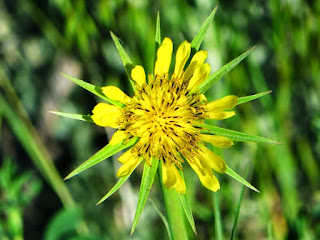Salsify and seed distribution
The salsify is one of my favorite mountain flowers. Its pretty yellow blossoms appear in the spring alongside Wasatch trails in lower elevations. The younger blossoms are actually kind of tasty to eat, if you can bear to pluck such a lovely flower and pop it in your mouth. The roots are also edible, and are said to have a taste reminiscent of oysters - hence one of the alternate names of the flower, oysterplant.
But it's the mature plants I want to talk about today. They form a seed head similar to the familiar dandelion head but much larger (see photo). The scientific genus name Tragopogon means "goat beard" (hence another of the plant's nicknames) in reference to the bristly seed structure.
I find this plant's mechanism of seed distribution to be beautiful, elegant, and utterly fascinating. Each individual seed is situated at the base of a tiny personal parasail. When the wind blows, the seed is detached from its stalk and carried away on the air current, as nearly weightless as a bubble (see attached video), to eventually come to earth in some remote location. The stronger the wind, the wider the distribution!
Plants reproduce in a variety of ways, helping keep their species alive in the environment where they thrive best. I'm sure most of the salsify seeds don't find the right conditions where they can root and germinate. But enough of them get distributed that at least some are likely to find ideal conditions, and thus ensure the survival of the species. I #GiveThanks for the subtle elegance of God's creation.





Comments
Post a Comment